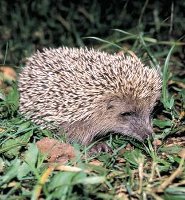 The Amur Hedgehog (Erinaceus Amurensis) is more commonly known as the Chinese Hedgehog. One of the fourteen different species of hedgehog that can be found in the world today, it is native to Amur Krai and Primorye in Russia, Manchuria in China, and the Korean Peninsula. The Amur Hedgehog is like any other hedgehog, They prefer tall grasses and undergrowth, such as under hedges and bushes. In the wild, their main diet consists of insects, worms, centipedes, snails, mice, frogs, and snakes. Hedgehogs in general were given the name because of the noise they make when foraging for food. Hedgehogs have very poor eyesight, so when foraging, they depend on their senses of smell and hearing rather than their eyesight. All that sniffing causes a pig-like grunt to be emitted, hence the name hedgehog.
The Amur Hedgehog (Erinaceus Amurensis) is more commonly known as the Chinese Hedgehog. One of the fourteen different species of hedgehog that can be found in the world today, it is native to Amur Krai and Primorye in Russia, Manchuria in China, and the Korean Peninsula. The Amur Hedgehog is like any other hedgehog, They prefer tall grasses and undergrowth, such as under hedges and bushes. In the wild, their main diet consists of insects, worms, centipedes, snails, mice, frogs, and snakes. Hedgehogs in general were given the name because of the noise they make when foraging for food. Hedgehogs have very poor eyesight, so when foraging, they depend on their senses of smell and hearing rather than their eyesight. All that sniffing causes a pig-like grunt to be emitted, hence the name hedgehog.Visibly, the Amur Hedgehog looks closest to the more common Western European Hedgehog, though it tends to be a lot lighter in color. The average weight of an Amur Hedgehog is 600-1000 grams (1.3 to 2.2 pounds) and it's average length can be anywhere from 5.5 to 12 inches (14-30cm). It's tail is usually 1-2 inches (1-6 cm) in length. The entire body of the hedgehog is covered in short, smooth spines that are used as a deterrent for predators.
Picture of the Amur hedgehog from http://lazovzap.ru
The Amur hedgehog, manchurian hedgehog is listed as Least Concern (LR/lc), lowest risk. Does not qualify for a more at risk category. Widespread and abundant taxa are included in this category, on the IUCN Red List of Threatened Species
Namings for the Amur hedgehog
A young / baby of a Amur hedgehog is called a 'hoglet'. The females are called 'sow' and males 'boar'. A Amur hedgehog group is called a 'array'.
Custom Search